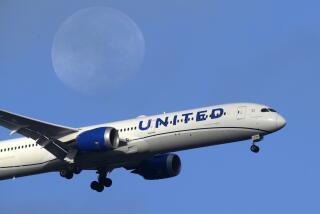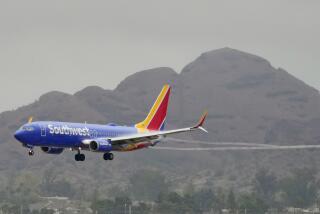Shuttle Launch : Airlines: United, competing for short-haul passengers, prepares to unveil its low-fare, frequent-flight service.
- Share via
Their faces flush and sweaty under a hot Central Valley sun, the United Airlines ground crew at Sacramento Airport raced against the clock to unload Flight 2258 from Los Angeles. In a test of United’s new shuttle service, the workers emptied the Boeing 737 jet of passengers and baggage, performed maintenance and safety inspections and then reloaded the 128-passenger plane for a return trip to Los Angeles in about 20 minutes. Normally, the same process takes twice as long.
“We are working harder and faster,” said ground crew worker Art Dalby, 53. “The faster we load (and the less time wasted on the ground), the more profit United will make on each plane. So we are doing our part.”
Welcome to the fast-paced world of Shuttle by United, the giant airline’s high-stakes gamble to win back the passengers and profit lost to efficient, low-fare rivals--Southwest Airlines, namely--on flights of two hours or less.
Despite numerous failures by United and others to fight off Southwest, Shuttle by United will begin flying Saturday with 184 daily flights to nine West Coast destinations after a few months of development and test flights. By year’s end, the Shuttle will serve 12 cities with 286 daily departures. Among major Southland airports, Shuttle will serve Los Angeles, Burbank and Ontario, but not Orange County.
“We are going to be very good at this short-haul niche,” said United co-pilot Joseph R. Noval.
Southwest will respond to the challenge by boosting flights in November. Between Oakland and Los Angeles, Southwest’s second-busiest route systemwide, the Dallas-based airline will add six flights for a daily total of 25. United will begin with 18 flights and grow to 20 by December.
“That is going to be our primary method of response,” said Edward Shelswell-White, Southwest’s Los Angeles marketing manager. “We will outdo them on frequency.”
Created by a team of United managers and workers, Shuttle includes many of the same features that have boosted the fortunes of Southwest: low fares, low costs, frequent flights and few frills. For example, the in-flight “meal” will consist of a beverage and a small bag of peanuts or pretzels.
However, United said it will set itself apart from Southwest, in part by offering a first-class section and assigning seats on the day of departure. (Advance seat assignments are not available.) In contrast, Southwest lacks any assigned seating, which results in a quick but often harried boarding that some passengers dislike.
Shuttle was born out of a nearly $5-billion deal in July that gave United’s employees a 55% stake in the Chicago-based airline. In return for majority ownership, workers--except for flight attendants, who did not participate in the buyout--agreed to wage cuts as well as more flexible work rules needed to begin an efficient, low-cost shuttle operation, then code-named U-2.
Shuttle cockpit crews, for instance, must fly more daily flights than their counterparts in United’s traditional “mainline” operation. That cuts down on time-consuming crew changes and allows a Shuttle jet to fly 12 1/2 hours a day, compared to nine hours for a mainline plane. Shuttle’s overall operating costs will be about 20% less than the mainline, United officials say.
Besides testing a new service, Shuttle is also an experiment for a variety of New Age management theories, ranging from worker empowerment to team building to total quality management. For example, workers have more freedom to make decisions related to their jobs without first asking for permission from management. Executives plan to transplant these theories to the rest of the airline in hopes of invigorating a bureaucratic corporate culture.
“Shuttle by United serves a little bit like a lab to encourage that process,” Shuttle President Sky Magary said. “It’s quite a different way of working.”
The differences between Shuttle and mainline service are driven by the need to cut time and costs. Every minute counts, as illustrated during a recent test of Flight 2258 from Los Angeles International Airport to Sacramento.
In an effort to reduce boarding time, passengers with window seats were boarded first, followed by customers in the middle and aisle seats. The unusual system, along with strict enforcement of carry-on baggage rules, saves about 10 minutes at the gate, United workers say.
Inside the cabin, flight attendants helped passengers load bags into overhead cabins to speed up boarding. As the 737 jet taxied toward the runway, flight attendants took beverage orders and later delivered them on trays instead of lumbering metal carts.
Flight attendant Len Gibson, a 27-year United veteran, said Shuttle’s simplified in-flight service reminded her of a less stressful and complex era when she worked on DC-6s.
“We have a lot more time to be personal with” passengers, Gibson said. “We are not overwhelmed. A little beverage service is nothing. We could do it blindfolded.”
On the ground in Sacramento, Capt. Corey J. Ferguson walked around his jet as part of the safety and maintenance inspection. Inside the cockpit, co-pilot Noval handled paperwork and programmed the in-flight computer.
“Before, we could get out into the terminal and take a stretch,” said Ferguson of the 45-minute layover that has now been halved. The routine is “more focused today.”
But the differences that make Shuttle a low-cost, low-fare carrier may also alienate and confuse customers accustomed to United’s full-service mainline. In 1981, United scrapped a similar low-fare, low-frills operation in part because of customer confusion.
Magary said the distinct personality and public image of Shuttle should prepare mainline passengers for any differences. Many Shuttle employees, for example, will be uniformed in casual polo shirts and shorts. Mainline employees will remain dressed in dark blue suits.
“We just have to get customers used to a little different system,” Magary said.
Back on Flight 2258, passengers did not seem to mind the differences--given that one-way fares ranged from $49 to $69. Neil Zachary, a 50-year-old state employee traveling on business, said he wants Shuttle to consider service to Burbank and Ontario from Sacramento. Zachary usually flies Southwest on those routes.
“If they go to these other destinations, I’ll switch,” he said.
United’s Shuttle at a Glance
United Airlines will go head-to-head with Southwest Airlines beginning Saturday by launching its short-haul, low-fare Shuttle by United.
Destinations: San Francisco, Los Angeles, Oakland, Las Vegas, Seattle, Ontario, Burbank, San Diego, Sacramento Daily Departures: 184 Employees: About 1,000 Planes: 30 737-300 jets by Dec. 31 President: Sky Magary
Routes One-way fares Los Angeles-San Francisco $49-$89 Los Angeles-Sacramento 49-69 Los Angeles-Oakland 49-69 Burbank-San Francisco 49-104 Ontario-San Francisco 49-104 San Diego-San Francisco 54-69 San Francisco-Las Vegas 74-99 San Francisco-Seattle 59-139
Note: All information as of Oct. 1. United will add destinations and routes through December.
More to Read
Inside the business of entertainment
The Wide Shot brings you news, analysis and insights on everything from streaming wars to production — and what it all means for the future.
You may occasionally receive promotional content from the Los Angeles Times.










